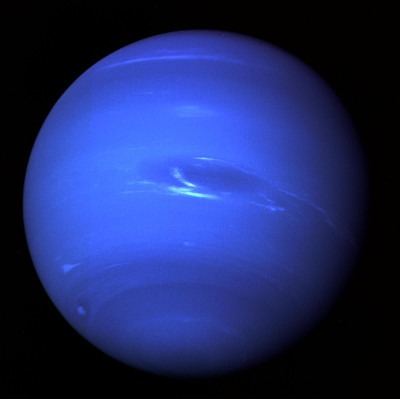The Grand Tour finale: Neptuneby Andrew J. LePage
|
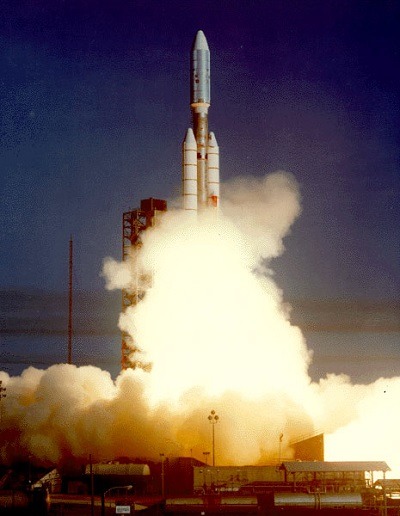 The launch of Voyager 2 on a Titan IIIE-Centaur on August 20, 1977. (credit: NASA) |
Getting to Neptune
The origins of the Voyager mission to Neptune can be traced back almost half a century to work originally performed by a NASA summer intern. In 1965, Gary Flandro discovered that as a result of a rare alignment of the outer planets that occurs only once every 176 years, it would be possible to launch a probe to Jupiter in the late 1970s and then have it fly by successively more distant planets for a reconnaissance of all the outer planets. By using this Jupiter gravity assist (JGA) technique, a larger payload could be launched and reach its destinations faster than was practical using a direct flight. In 1969, NASA formally began design of the mission that was popularly referred to as “The Grand Tour.”
| The option for Voyager to continue on to Uranus was publicly downplayed by JPL in the months leading up to launch, while the Neptune option was never even mentioned. |
NASA planners originally envisioned building a set of highly advanced, nuclear-powered probes called TOPS (Thermoelectric Outer Planet Spacecraft) capable of studying a succession of outer planets during a decade-long mission. This flight time was many times longer than had been demonstrated by any spacecraft at that time and would require many engineering advances. While many options were considered, among the more widely disseminated involved the launch of a pair of spacecraft in 1977 that would explore Saturn and Pluto after their JGA. Another pair would be launched in 1979, first towards Jupiter and then on to Uranus and Neptune. This Grand Tour would be completed when the last of the second pair of spacecraft reached Neptune in early 1988.
Unfortunately, NASA’s plans for the Grand Tour proved to be overly ambitious and far too expensive with an estimated price tag of $900 million (equivalent to over $5 billion today.) In 1972, NASA scaled back the mission to a single pair of Mariner-class spacecraft that would take advantage of the 1977 launch window to Jupiter and Saturn. Originally designated “Mariner Jupiter-Saturn 1977” but renamed “Voyager” in early 1977, this more modest mission was managed by the Jet Propulsion Laboratory (JPL) and could be completed with a shorter flight time of four years at an estimated cost of $250 million. While NASA attempted to salvage more of their Grand Tour using Voyager-class spacecraft including a “Mariner Jupiter-Uranus 1979” proposal, in the end they never advanced beyond paper studies because of the lack of available funding, as well as a much less expensive (but riskier) option.
In 1974, it was discovered that in addition to the Jupiter-Saturn launch window in the late summer of 1977, there also existed an overlapping launch window that allowed a spacecraft to follow a slightly slower trajectory that could continue on to Uranus and Neptune after passing Saturn. One of the major drivers behind the decision whether or not to exercise this option was Saturn’s largest moon, Titan (see “The mysteries of Titan”, The Space Review, November 8, 2010). Making close-up observations of Titan with its dense, hazy atmosphere was a primary objective of the Voyager mission. Unfortunately, there were no trajectory options at this time that allowed a close pass by Titan while preserving an option to reach Uranus. NASA decided that if the first Voyager spacecraft met its objectives at Titan and if the second spacecraft was still in good health with sufficient consumables remaining, it would exercise the option to send the second Voyager to Uranus and Neptune. But given that the encounters with Uranus and Neptune would not occur until more than 8 and 12 years after launch, respectively, the chances of success were deemed to be very low. The option for Voyager to continue on to Uranus was publicly downplayed by JPL in the months leading up to launch, while the Neptune option was never even mentioned.
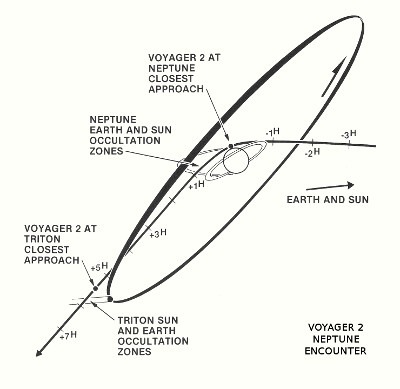 Diagram showing the trajectory of Voyager 2 past Neptune and Triton. (credit: NASA/JPL) |
The beginning of the voyage
The first Voyager to be launched followed the slower Jupiter-Saturn-Uranus-Neptune trajectory. To avoid confusion later on, NASA called the first spacecraft launched on August 20, 1977, “Voyager 2.” The second spacecraft launched on September 5, which followed the faster Jupiter-Saturn trajectory, was designated “Voyager 1.” Despite being launched 16 days later, Voyager 1 beat its twin to Jupiter by four months and reached Saturn nine months earlier. Both Voyagers experienced minor problems after launch, but these were quickly corrected as the spacecraft settled into their long cruise to Jupiter. During this time, ground controllers also optimized the configuration and improved the performance of the spacecraft with software modifications. These improvements, along with an optimal launch date and a near-perfect injection into the proper trajectory, meant that Voyager 2 would have more than sufficient consumables to reach Uranus.
Everything looked good for Voyager 2 until April 5, 1978, when its primary receiver permanently failed and controllers discovered that its backup receiver was faulty. A bad component in the backup receiver made it impossible for it to lock onto the Doppler-shifted frequency of signals transmitted from Earth. After eight days of effort, ground controllers finally got a response from Voyager 2 and slowly reestablished regular contact with the spacecraft. Eventually engineers learned to predict which frequency to transmit from Earth so that Voyager 2 could detect it but the prospects of this craft completing it primary mission with just one balky receiver dimmed. The idea of an extended mission beyond Saturn seemed doubtful.
| Voyager 2 hit its target 81,600 kilometers above the cloud tops of Uranus on January 24, 1986, sending it on its way towards an August 1989 encounter with Neptune. |
Against all odds, contact with Voyager 2 was maintained. It successfully flew by Jupiter on July 9, 1979, and was sent on its way to Saturn. After Voyager 1 met its primary objectives at Titan and Saturn with a successful flyby on November 12, 1980, Voyager 2 was retargeted so that it would pass through an imaginary point 101,000 kilometers (63,000 miles) from Saturn to slingshot on to Uranus. Voyager 2 successfully met its inbound science objectives and made its closest approach to Saturn on August 26, 1981. However, 100 minutes later, the platform holding the cameras and other remote sensing instruments jammed. Within a couple days, engineers at JPL were able to free the platform but much of the post-flyby data was lost. In time, the problem was traced to excessive use of high slew rates in azimuth that forced lubrication from the actuator’s gears. Engineers believed that restricting the number of slews and the slew rate of the platform would prevent a recurrence of the problem. If the azimuth actuator seized again, they developed a technique to free it using thermal cycling. But just in case the platform permanently froze in azimuth, the entire spacecraft could be rolled to point the instruments while still using the platform’s elevation actuator. Voyager 2 had enough propellant for 150 such roll maneuvers at Uranus, but the Neptune option would be in danger.
During Voyager’s quiet four-and-a-half-year cruise from Saturn to Uranus, program scientists and engineers were busy not only planning for the upcoming encounter, but also making improvements to the spacecraft’s software and facilities at NASA’s Deep Space Network (DSN). These improvements allowed Voyager 2 to perform better under the low light conditions at Uranus, as well as transmit up to 200 images each day despite the growing distance (see “The Grand Tour: Uranus”, The Space Review, January 24, 2011). Fortunately, Voyager 2 remained healthy and the scan platform problem did not reoccur. Voyager 2 hit its target 81,600 kilometers (50,700 miles) above the cloud tops of Uranus on January 24, 1986, sending it on its way towards an August 1989 encounter with Neptune.
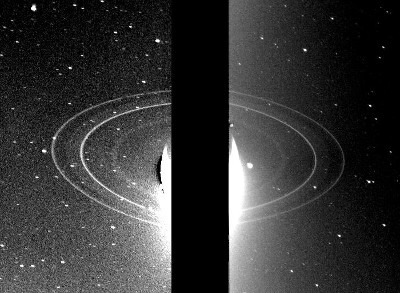 A pair of Voyager 2 images with exposure times of ten minutes showing Neptune’s ring system. The brighter ring arcs were out of view in both images. (credit: NASA/JPL) |
The frontier
When Voyager 2 reached Neptune, it was the farthest planet from the Sun and represented the frontier of the solar system (even though Pluto was still considered a planet, it was inside Neptune’s orbit at this time). And being so distant, not much was known about Neptune despite almost a century and a half of study since its discovery in 1846. Neptune, with a diameter of 49,500 kilometers (30,800 miles) and a mass 17 times that of the Earth, was a bit smaller but slightly more massive than Uranus and was generally expected to be very similar.
Unlike Uranus, which had an orderly set of moons orbiting near its equatorial plane, Neptune was known before the encounter to have only two satellites in very odd orbits. The smaller moon, Nereid, is in a distant, highly eccentric orbit that takes almost a full year to revolve around Neptune. The larger moon, Triton, is in a six-day orbit inclined 157° to Neptune’s equator—the only large moon known to be in a retrograde orbit. Given Triton’s odd orbit, scientists theorized that Neptune had captured it in the distant past. This event would have disrupted any regular system of moons Neptune originally possessed and probably ejected Nereid into its odd orbit.
Very little was known about these moons, which appeared only as points of light in Earth-bound telescopes. Based on its brightness, Triton was certainly large but its exact diameter was unknown, with estimates ranging from 2,200 to 5,000 kilometers (1,400 to 3,100 miles). It was even possible that Triton could have been the largest moon in the solar system. Spectral studies of Triton had detected methane and nitrogen, hinting that this moon had an atmosphere. But without more information about its size and temperature, models for Triton ran the gamut from a tiny, frozen world with a thin atmosphere and extensive methane and nitrogen ice deposits on its surface, to a world rivaling Ganymede in size with a thick, haze-filled atmosphere like Titan and oceans of liquid nitrogen covering its surface.
With the discovery by means of stellar occultation of a dark set of narrow rings encircling Uranus in 1977 (and subsequently studied close up by Voyager 2 in 1986), astronomers wondered if Neptune also had its own ring system. Astronomers made about 40 attempts during the 1980s to observe occultations as bright stars passed near or behind Neptune, with puzzlingly mixed results. Dips in the observed brightness of stars would be definitively observed on one side of Neptune but not at the same distance on the other. Other times, no changes would be observed at any distances. The general consensus of the astronomical community at this time was that Neptune possessed a system of ring arcs and maybe small shepherding moons ranging from about 56,500 to 70,000 kilometers (35,100 to 43,500 miles) from the center of the planet.
| With these enhancements, the maximum data rate from Neptune would be the same as it was from Uranus in 1986 despite the greater distance. |
With so little known about Neptune and with no need for Voyager to hit a specific aim point to reach another planetary target, mission planners were free to choose a trajectory past Neptune that maximized the science Voyager 2 could gather. Between Neptune’s north pole being tilted back during its northern winter and the inclination of Triton’s retrograde orbit, the only way for Voyager 2 to pass close to Neptune and Triton was to flyby Neptune’s northern polar region as close as ground controllers dared so that the spacecraft’s trajectory was bent down enough to pass close to Triton. And the closer the pass by Neptune, the closer the flyby past Triton would be.
In the end, Voyager 2 was aimed to make its closest approach over the northern polar region 29,180 kilometers (18,140 miles) from the center of Neptune or an estimated 4,950 kilometers (3,080 miles) above the level where Neptune’s atmospheric pressure equal that at Earth’s surface. This aim point would bring Voyager 2 no closer that 78,380 kilometers (48,710 miles) of Neptune’s center on the inbound ring plane crossing and allow a 40,000-kilometer (24,900-mile) flyby of Triton. This trajectory would also allow Voyager 2 to pass behind Neptune and Triton as viewed from the Earth so that their atmospheres could be probed by the spacecraft’s radio transmissions.
While Voyager 2 had a number of enhancements made to its software to better deal with the low-light conditions at Uranus, more modifications would be needed for the Neptune encounter. Lighting levels at Neptune were 40% of those at Uranus and only 3% of what they were at Jupiter. For the Neptune encounter, typical “short” exposure times for imaging would be 15 seconds long with many being measured in minutes. Changes were made to the attitude control system and when the tape recorder was turned on (which caused small torques that turned the spacecraft slightly) to make Voyager 2 even more stable. In order to compensate for the apparent motion of targets during close encounters, more precise image motion compensation techniques were programmed into Voyager. In addition, the magnitude of attitude changes during target tracking were decreased so that Voyager’s antenna would stay more accurately pointed towards the Earth to maintain the flow of data and minimize the need to record data.
Image compression procedures used by Voyager 2 at Uranus were retained but additional measures were needed to keep data flowing from Neptune. NASA upgraded the 64-meter (210-foot) antennas at the three DSN stations, enlarging them to 70 meters (230 feet) to increase their sensitivity by 58%. A new high-efficiency 34-meter (112-foot) tracking antenna, which could be electronically linked with the nearby 70-meter (230-foot) antenna, was completed at the DSN station near Madrid, Spain, like the ones already in place at the stations at Goldstone, California, and Canberra, Australia. Despite these upgrades, NASA desired still more downlink capacity.
NASA enlisted the services of the Very Large Array (VLA) radio telescope in New Mexico for the Neptune encounter. Consisting of an array of 27 antennas, each with a diameter of 25 meters (82 feet), the VLA only required minor modifications to receive data from Voyager with the equivalent sensitivity to two of the DSN’s large antennas. Since the southern hemisphere would have the best view of Neptune during closest approach, the Canberra DSN facility was once again electronically linked with the 64-meter (210-foot) Parkes radio telescope, as it had been during the encounter with Uranus. In addition, the 70-meter (230-foot) tracking antenna in Usuda, Japan, which was originally constructed to support the Japanese mission to Comet Halley, would aid in data reception (see “A chance of a lifetime: the missions to Comet Halley”, The Space Review, March 14, 2011). With these enhancements, the maximum data rate from Neptune would be the same as it was from Uranus in 1986 despite the greater distance.
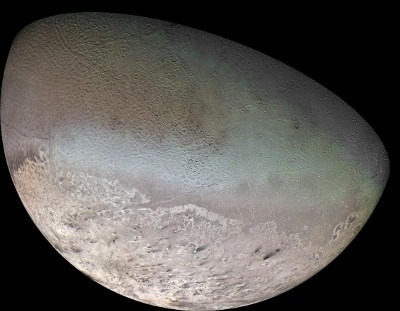 A mosaic of color and high-resolution images of Triton acquired by Voyager 2. (credit: NASA/JPL) |
The encounter with Neptune
Voyager 2 began its “distant observatory” phase of its encounter on June 5, 1989, at a range of 117 million kilometers (73 million miles). Even at this distance, Voyager’s images of Neptune, with a resolution of 1,140 kilometers (710 miles) per pixel, were already four times better than the best images from Earth at the time. During this phase, Voyager discovered its first new moon of Neptune: scientists found the 420-kilometer (260-mile) diameter Proteus in a circular orbit with a radius of 117,600 kilometers (73,100 miles). Because scientists found it so early, the project team reprogrammed Voyager to make close-up observations. By early August, Voyager found three more, smaller moons with circular, prograde orbits inside that of Proteus.
The “far encounter” phase started on August 6. Images of Neptune revealed a much more dynamic atmosphere than that of Uranus as it appeared in 1986. Scientists saw a storm they dubbed “The Great Dark Spot” along with other cloud features that allowed them to measure the planet’s winds. By August 11, Voyager took the first images of Neptune’s ring arcs. Later images revealed that the arcs were actually concentrations of particles in one of five continuous rings of various widths and properties encircling Neptune that stretched as far as 63,000 kilometers (39,000 miles) from Neptune, along with yet another pair of small moons. Neptune’s compact system of “regular” small satellites and a ring system was similar to that of Uranus, albeit with its own distinctive character. In any case, Voyager 2 would pass at a safe distance from these rings.
Early observations of Triton by Voyager showed that it was only 2,700 kilometers (1,700 miles) across, with extensive bright frost deposits in its southern polar area that was pointing towards the Sun. Triton was clearly a small, frozen world and a close analog to Pluto, which neither of the Voyager spacecraft would be able to visit to round out the original “Grand Tour.” On August 22, Voyager performed its final course correction maneuver just two days after the twelfth anniversary of its launch, using only its roll thrusters to minimize changes in the balky receiver’s temperature.
Just over 12 hours before closest approach, Voyager started its fast-paced “near encounter” phase. Less than an hour earlier, Voyager 2 had already entered Neptune’s magnetosphere. Like the magnetic field of Uranus, Neptune’s field was found to be a dipole not only tilted 47° to the planet’s rotational axis, but offset by 0.55 radii from the planet’s center. As luck would have it, Voyager 2 entered Neptune’s magnetosphere almost pole on, allowing it to make unique observations at high magnetic latitudes. About an hour into the “near encounter” phase, Voyager got its best images of distant Nereid from a range of 4.7 million kilometers (2.9 million miles). The featureless crescent of Nereid showed that it was only 340 kilometers (210 miles) across and was now demoted to being the third largest moon of Neptune behind the newly discovered Proteus.
Just under an hour before closest approach, Voyager 2 passed through Neptune’s ring plane unscathed. At 3:56 UT on August 26, Voyager reached its closest point to Neptune: 29,240 kilometers (18,170 miles) from its center and just 30 kilometers (19 miles) off target. At 4,905 kilometers (3,408 miles) above Neptune’s cloud tops, this was the closest Voyager 2 would come to any planet or moon during its long 12-year mission. Six minutes after closest approach, Voyager passed behind Neptune for 47 minutes, allowing the spacecraft’s radio waves to probe the planet’s atmosphere and rings.
| These unique observations from Voyager’s Neptune encounter are likely to be our only such data for quite some time to come. |
Two hours after its closest approach with Neptune, Voyager 2 devoted its attention to Triton for the next five hours. Voyager 2 acquired several series of detailed images, showing bright polar deposits and a variety of different terrain. The lack of impact craters suggested that Triton has been resurfaced and was relatively young. Infrared measurements of Triton’s southern polar cap barely registered at a temperature of only 38 K (–392° F), showing it was composed of frozen methane and nitrogen. Despite the cold temperatures, images revealed geysers filled with dark dust erupting through parts of the evaporating polar caps.
The closest approach to Triton occurred at 9:10 UT on August 26 at a range of 39,800 kilometers (24,700 miles) from the moon’s center. Shortly thereafter, Voyager slipped behind Triton for three minutes, allowing its atmosphere to be probed. Combined with other data, scientists determined that Triton’s atmosphere is composed primarily of nitrogen with a surface pressure less than 0.012% of Earth’s. Despite the thinness of the atmosphere, it was dense enough to support a thin haze layer and blow dust from the surface geysers far downwind to create prominent dark streaks. Spacecraft tracking also revealed that Triton had only 29% of the mass of the Moon and with a density only twice that of water, indicating that it was likely composed of an even mix of water ice and rock.
As Voyager 2 pulled away from Neptune, it continued making observations, completing its “near encounter” phase on August 29. The “post encounter” phase followed until October 2, officially ending the last planetary encounter of the Voyager program. Voyager 2 would join its twin on an extended “ISM” (Interstellar Mission) that continues to this day, as does the study of their data. These unique observations from Voyager’s Neptune encounter are likely to be our only such data for quite some time to come. Even under the most optimistic scenarios, follow-on missions to Neptune currently under study would not be visiting this distant ice giant for at least another three decades, if not longer.
References
Andre Brahic and William B. Hubbard, “The Baffling Ring Arcs of Neptune”, Sky & Telescope, Vol. 77, No. 6, pp. 606–609, June 1989
Ellis D. Miner, “Voyager’s Last Encounter”, Sky & Telescope, Vol. 78, No. 1, pp. 26–29, July 1989
E.C. Stone and E.D. Miner, “The Voyager 2 Encounter with the Neptune System”, Science, Vol. 246, No. 4936, pp. 1417–1421, December 15, 1989
Paolo Ulivi with David M. Harland, Robotic Exploration of the Solar System: Part 1: The Golden Age 1957–1982, Springer, 2007
